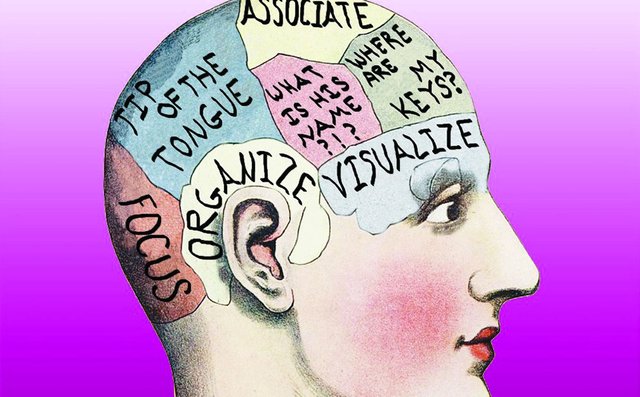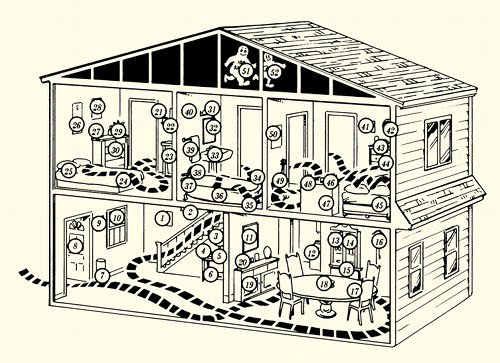The Art and Science of Mnemonics: A Step by Step Guide to Dramatically Boost your Memory

Do you forget people's names as soon as you hear them? Forget appointments and things you need to do? Do you ever forget why you walked into a room?
You're not alone. But I want you to grasp one thing right now: your memory is not a fixed trait.
Memory a skill that can be learned and enhanced with a little bit of practice.
My memory was never that good to begin with, and a few years back, it got a lot worse when I started having to deal with brain fog as a side effect of a chronic illness called Meniere's disease. Brain fog is a kind of cognitive impairment caused by dozens of different chronic health conditions and can severely impair memory and recall.
So I dove into the fascinating world of mnemonics to try to improve my ability to remember.
And I learned that by understanding the inherent strengths and weaknesses of our natural memory capabilities and using techniques to leverage the strengths we can drastically improve our memory very quickly.
A Picture is Worth 1000 Words - the Linking Technique:
As a general rule of thumb, most of us are bad at remembering numbers, lists of words, and abstract concepts. However, we're typically very good at remembering images, stories, physical locations, and places they know.
The simplest technique for improving our memory is to take information we find difficult to remember and transform it into something that our brains can easily recall.
This practice is known as “Linking” and all it takes is a little bit of imagination. It's a powerful memory hack, one that you can start using right away.
All you have to do is take the thing you wish to remember and turn it into a story with vivid, exaggerated images in your mind.

To demonstrate, I will walk you through the process of remembering the following ten-item grocery list: Eggs, Beef, Green Beans, Celery, Fish, Chicken, Guacamole, Bananas, Ice Cream, and Orange Juice.
Read the following ridiculous story slowly and carefully. As you read, really try to vividly imagine the scenes in your mind:
The Easter Bunny is sitting on top of a ladder in the middle of a field, violently throwing giant, brightly colored Eggs at Cows grazing in the field. The cows moo loudly in protest.
Across the field, Mickey Mouse is laying in a large hammock, made out of a single giant Green Bean. Mickey is drinking a bucket-sized Bloody Mary with a whole stalk of Celery sticking out.
Suddenly, Mickey turns to see a large Fish with human legs, chasing a two headed Chicken across the nearby road. The two headed chicken dives into an Olympic-sized swimming pool filled with Guacamole on the other side of the road to hide from the fish.
The fish gives up on the chicken and heads home and, to his delight, finds his bathtub is filled with a massive Banana Split Ice Cream Sundae.
He eats the entire thing and turns on the faucet to clean out the tub only to find heavy pulp Orange Juice coming out. He shrugs and takes a drink.
Perfect Recall:
Before we continue, I want you to go back, reread the story one more time and really imagine it in as much detail as possible. Once you’ve done that, look away from the browser and grab a pen and a piece of paper.
In your mind, I want you to play back the story.
Mentally walk through the details of the story, and as you get to each image, write down the corresponding grocery item it represents. For instance, when you get to the cows, you write down beef.
I’m willing to bet you were able to remember the whole list. Pretty amazing, right?
By taking the information you need to remember and transforming it into a vivid and imaginative story, you will have a much easier time remembering.
When choosing images and scenarios for your story, the more extreme, exaggerated, disgusting, crazy, humorous, and dramatic, the better. We remember things that invoke emotion, whether shock, disgust, laughter, sadness, etc., with much greater clarity than mundane, random facts.
Memory Palace Technique:
Earlier I mentioned that people are naturally very good at remembering places they know.
This is because a large amount of mental energy is devoted to navigating our environment. The "Memory Palace" technique builds on the concept of linking by taking advantage of this natural tendency of memory.
It is fun to use, easy to learn, and has been around since the time of Ancient Rome.
I’ll show you:
Close your eyes, and imagine you are standing at the front door of the home that you grew up in. Open the door and mentally walk through the layout of your childhood home. You can probably remember the layout with a surprising level of detail.
You may be surprised to find you can clearly remember the layout of most places you visit frequently.
Combining this natural ability with the vivid imagery of linking creates a powerful framework for remembering information.
By mentally placing vivid images that represent what you are trying to remember (linking) throughout a well-known location, you can easily recall the images later on by walking back through the location in your mind.
The term “memory palace” refers to any location you can easily visualize and use to store and remember information.
Building a Memory Palace:
To get started, choose a location that you know perfectly, such as your current home.
Next, identify 10 different locations within your home, in order of how you would actually walk through your home.
For example, the first location could be your driveway, the second location might be standing outside your front door, the third location, the room on the inside of the front door, and so on. Make sure each hallway or room is counted only once.
Once you have identified 10 distinct locations within your home, close your eyes and mentally walk through the locations, in order, several times. Once you have it firmly in your mind, you can populate each location with an image that corresponds to what you are trying to remember.

(Image Source: Art of Manliness)
If you think back to our grocery list example, you could imagine a giant Easter Bunny carrying a basket of large Eggs at the base of your driveway, while a herd of cows rushes towards your front door (representing Beef).
Inside your front door, you find Mickey Mouse drinking a bucket-sized Bloody Mary with a full stalk of Celery sticking out. You get the idea.
When each of the 10 locations has an image stored, you should be able to recall each image by mentally walking through the memory palace. Give it a try! The first time I recalled a list correctly, I felt like I had discovered a super power.
Your Body is a Palace:
A simple variation of this technique is to use physical places on your body, rather than rooms in a house, as locations to store information. First, you need to remember the following ten locations on your body, in order.
- The top of your head
- Your nose
- Your mouth
- Your ears
- Your throat
- Your shoulders
- Your collar (by your collar bones)
- Your fingers
- Your stomach
- Your butt
Go through this list several times and touch each location on your body as you read each location. It will help you commit it to memory. Once you have it down, you can use each location to store a piece of information.
We'll use our grocery list example again.
First, imagine the Easter bunny sitting on the top of your head, holding a basket of Eggs. Next, picture a hot dog sticking out of each nostril of your nose to represent Beef.
Now imagine yourself chomping on a giant, baseball bat-sized stalk of Celery, and so on. Once you have an image for each location, you can easily recall them by mentally going through the list of locations on your body.
Conclusion:
With all of these techniques, you can learn to do incredible, seemingly impossible things, like memorizing a shuffled deck of cards. Much to my surprise, I was able to do it with only several hours of practice.
There are even international memory competitions where participants compete with each other to accomplish insane feats of memory. The world record for memorizing a shuffled deck of cards is a mind-blowing 20.44 seconds.
But the bottom line here is that you can improve your memory and recall ability in a big way with only a little bit of practice.
You can unlock the super power of memory, too.
Thank you for the post! The memory palace technique has helped me a lot improving my memory last year and I believe this information is not shared enough.
I remember a lot of people and details of their lives and they think it's amazing. people like to know that someone took time to remember them. Awesome post.
Thanks @runridefly!
I already use this technique to remember Steemit article ideas that come to me whilst out shopping. Great explanation by the way.
That's awesome. Here's another good trick you can use to remember post ideas when you are falling asleep. Create an image to remember the idea and visualize it in the first place you go to when you wake up in the morning, like the bathroom. When you wake up and walk into the bathroom, you'll remember.
I'm voting in the vegan "Olympic-sized swimming pool filled with Guacamole", yay!
i thought its a banana sundae ice cream swimming pool!!
Awesome breakdown. I read "Moonwalking with Einstein" by Joshua Foer and it was an amazing book about these memory tricks and the memory competitions that happen every year.
It's been on my "to read" list for so long but I never got to it. I have followed Ed Cooke though who coached Josh Foer in the book. I learned how to memorize a deck of cards from Ed's company!
Oh wow, that's really cool! He is a character from everything I read haha. What an awesome service to provide for others.
cool..maybe i can try this and prevent early dementia ;) am sure is heading that way.
Really good post, thanks, my memory is always failing me.
It's funny, I have an excellent memory (some have described it as photographic), and I have used this technique to try and improve it even further.
However, try as I might; the technique won't work for me; when I usually remember stuff; especially mundane things. I remember stuff like, how I felt at the time, it's weird I can't explain it.
Some other things, I remember the inflection in the voice of the person telling it to me. If they spoke in a monotone, I won't remember it.
I've always found it strange...I'm very annoying to argue with, as long as I stay relatively calm, I can remember every word of arguments I've had, which makes it impossible to lie to me. :-)
Cg
Mnemonics RULE!
These techniques have been used for centruies to remmeber everything from names and face to entire religious texts!!
Great Post
If you are interested in taking your mnemonics practice to the next level, check out this website
Pmemory.com
They have developed a technology by combining mnemonics methods and developed a practical training!
Memorize Entire Books in 60 days!!!
I have been a student for a while, just check out the first lesson, and you will see how powerful it is!!
liked and followed! great post man keep it up i love to see people post about learning technology.